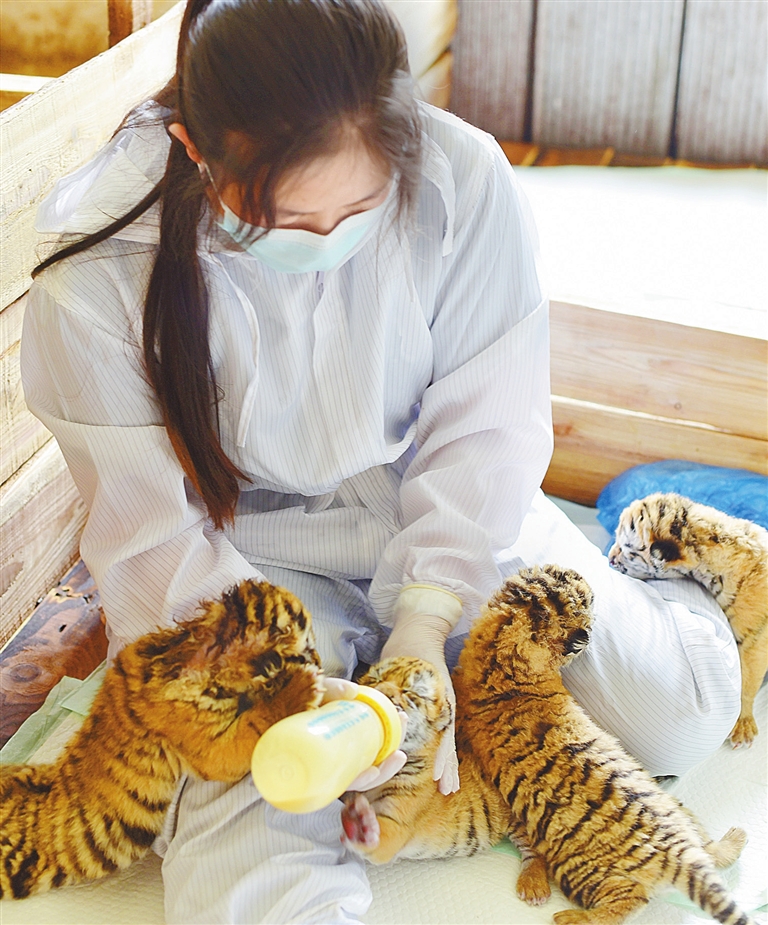
ONE month after their birth, four Siberian tiger cubs are getting stronger at Hengdaohezi Siberian Tiger Park in Mudanjiang, Heilongjiang Province. The four cubs, a male and three females, were born May 29 at the park, one of the three parks of the China Hengdaohezi Feline Breeding Center, the world’s largest breeding center for Siberian tigers. The other two are located in Heilongjiang’s Harbin and Shenyang in Liaoning Province. Siberian tigers are among the world’s most endangered species. They mainly live in northeastern China and eastern Russia. The mother of the quadruplets is a 17-year-old tiger who is also the oldest mother at the park. “Usually, tigers can reproduce from the age of 4 until age 14,” said Liu Dan, an expert on tigers at the center. “It is rare to see a tiger giving birth at 17.” “The four cubs are in good health,” said Zang Yingying, a breeder at the park. Their average weight has climbed from about 1 kg each when they were born to more than 2.5 kg as of June 21. Zang said the mother tiger has given birth eight times over the past few years and kept in good condition during her 108-day pregnancy. “She was moved to separate living quarters in a specialized area at the beginning of her pregnancy,” she said. “Every day, breeders carefully disinfected both the indoor and outdoor living areas.” The temperatures in the living quarters were maintained at 17 to 20 degrees Celsius, so that the tiger would feel comfortable. Breeders paid greater attention to her health by monitoring her appetite and daily activities. In the early morning of May 29, she gave birth to the four cubs over about four hours, a much shorter time than that was observed with other tiger mothers. “Now she can eat up to 7 kg of pork and chicken every day,” Zang said. “In addition, we prepare an ample supply of nutritious foods for her, including fresh goat’s milk and eggs, as well as several kinds of vitamin pills, to help her regain her strength and to produce enough milk for her babies.” Zang said that when the cubs grow older, breeders will feed them chopped meat. “Not all adult Siberian tigers are fit to reproduce,” said Liu. “Researchers conduct DNA tests to select parents and prevent inbreeding.” “Most Siberian tigers have more than one cub at a time, and it is common for a mother tiger to give birth to two to three,” said Liu. “Sometimes, we get the chance to see healthy litters of four and five.” Early spring is the mating season for Siberian tigers, usually in January and February. Starting in May, the park entered its peak season for newborn tiger cubs. So far, 23 tiger cubs have been born, and the park is expecting the birth of more than 50 tiger cubs this year. China has been trying to save the species through artificial breeding programs. From the initial group of 20 tigers, when it was established in 1986, the center now has more than 1,000 tigers, including 400 in Hengdaohezi. Researchers have also tried to prepare the animals for survival in the wild. “About six months after the cubs’ birth, they can be put into a training ground beside the training ground for adult tigers,” said Liu. “Breeders feed them live chickens and ducks. While the adult tigers catch and hunt, the tiger cubs can watch and learn the skills.” In 2020, Liu and his team developed a method of training the young tigers in the wild, which has proved effective. “Wilderness training is an important way to maintain their health and hunting ability,” he said. “I hope one day we can return these artificially bred animals into the wild,” Liu said. (China Daily) | 
